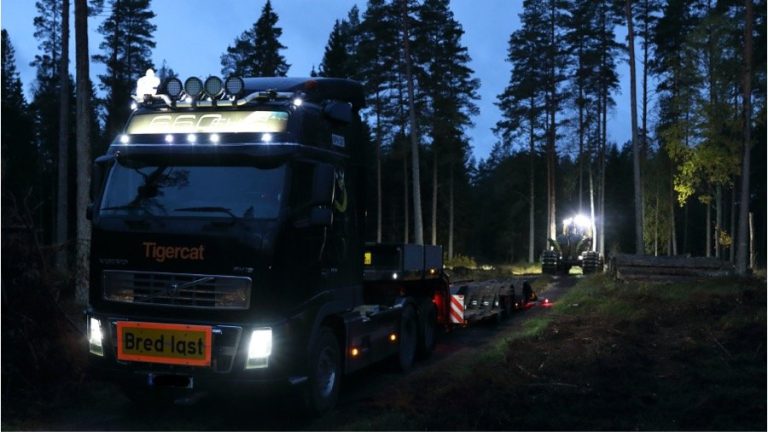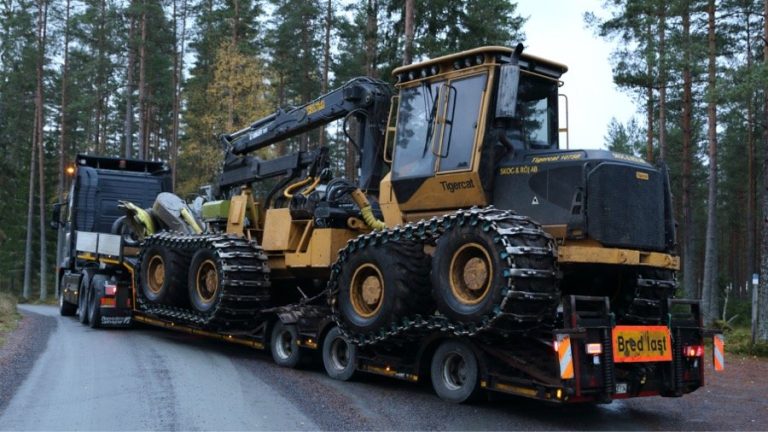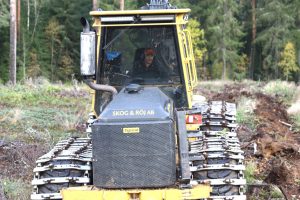Modern forest machines are not built for the streets. The transmission, often hydrostatic is made for the terrain and make the machines very slow on roads. It´s a matter of planning to avoid long moves so that you can drive the machine between sites as often as possible. But sometimes you will need a truck with a machine trailer to do the job.
Moving a forest machine
I decided to go and see a machine move with a trailer. I visited George Löfgren who owns and operates a scarifyer. As the average site is quite small for him, he moves his machine 1 – 4 times a day. Furthermore, he always has tracks on the machine – on all wheels. So, for him it´s a good idea to have his own truck and trailer as he never could drive the machine on the road without removing and put on the tracks every time.
The machine is a Tigercat 1075 equipped with a Bracke T26 trencher. A nice piece of equipment that weighs 28 tons. The truck is a 660 hp Volvo FH16 that is not of latest model. As the truck mainly is parked in the forest while George is scarifying there is no point in having a new truck, he thinks.
Morning move
As he moves so often it took some planning for me to arrive at the right time. It happened to be in the morning, not giving it the slightest thought that it´s dark in the mornings at this time of the year. So, the first photos and film clips may be a bit dark.
It was a short move this day, only 7 – 8 kilometers. The other day, the move was a lot shorter as the site we now were leaving was on both sides of a public, asphalt, road. To avoid that the aggressive tracks should damage the road, George loaded the machine on the trailer just to take it over to the other side. A move of about 20 meters. He didn´t want to comment whether he secured the machine properly to the trailer for that move or not.
It´s obvious that George is doing this often. Everything is prepared and he knows exactly what to do. As he mainly moves his own machine with his trailer, everything is adapted for that. The load securing chains are always in their place. A protection plate to place the trenching discs on is always there. So, except for this day when we had to wait for some light for my sake, all George must do is to drive the machine on to the trailer, secure it with the chains and off he goes. That process normally takes 5 – 15 minutes.
Checking out the new site
Normally there has been timber trucks on or close to all the sites that is to be scarified. Therefor you can count on that a truck with a machine trailer can go there too. But here we are talking about two different types of trucks. Furthermore, George must park his truck somewhere during the job, somewhere where it´s not in the way.
As the new site was located close to a growing industry area, George had been there the day before with his car to check the roads and possibilities to park the truck. It turned out that on the industry estate, the road had been moved and wasn’t at all where it was on the map. In other words, in this case it was a good idea to go check with the car before he went there with the truck and the machine.
The move
Thanks to experience and good planning the move this morning went smooth. George only made the wrong turn once, but that was on the industry estate where there were lots of possibilities to turn around. In his defense, there had been changes done in one of the crossroads where he was to make a turn, since the day before.
We arrived on the new site, unloaded the machine, parked the truck and then George could start working with what he is supposed to do – scarifying.
In this film clip below you can follow the move:
More on ground preparation
If you are interested in ground preparation for planting, you can read and see a film about it here.
Film and photos: Per Jonsson














